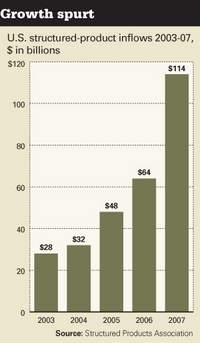Reverse convertibles and other structured investments promise to boost returns and limit risks.
By Michael Iver and Jon Asmundsson
(Bloomberg Magazine, November 2007) -- In the years after the dot-com bubble burst in 2000, U.S. investors were hungry for anything that could give their portfolios a boost—or at least stanch the bleeding. Stocks plunged. The Standard & Poor’s 500 Index lost half of its value from its 2000 peak to its low in 2002. Bonds or money markets didn’t look much better. Yields on Treasuries fell to the lowest in four decades.
There was nowhere to hide . . . and a new class of securities gained a foothold on Wall Street. Managers of assets for high-net worth investors led the trend, offering debt instruments designed to mimic derivatives- based strategies. These securities promised a way to limit losses and enhance returns, and they became known as “structured” investments.
“Around 2000–2003, structured products became very prominent in portfolios of private banks such as JPMorgan and Merrill Lynch and Morgan Stanley,” the Structured Products Association said in a report on the subject. The new approach “was so useful that they started mass marketing it for retail investors at minimums of $1,000,” it says.
Protecting against further drops in the stock market was key, says Rhian Horgan, global head of equity derivatives at JPMorgan Chase & Co.’s private banking arm, which oversees $430 billion for its clients, who include more than 180 billionaires. Investors hurt by the S&P 500 Index’s slide from 1,553 to 769 wanted protection before they would even consider buying stocks again. “So we started putting together strategies that gave clients some protection on the next 10 percent downside in the equity market, and they financed that by selling away the upside above 14–15 percent annualized returns,” Horgan says.
For the full feature in Bloomberg Magazine, click here.
Wednesday, June 25, 2008
Subscribe to:
Post Comments (Atom)



No comments:
Post a Comment